Themed collection Editor’s collection: Chromism in Frameworks

Unravelling chromism in metal–organic frameworks
Chromophoric MOFs are reviewed, focussing on those which change colour on application of external stimuli such as heat, pressure, light or chemical environment.
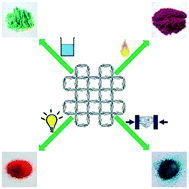
CrystEngComm, 2017,19, 4238-4259
https://doi.org/10.1039/C7CE00710H
Solvatomorphism of Reichardt's dye
Six different crystal structures are obtained depending on the crystallization solvent.
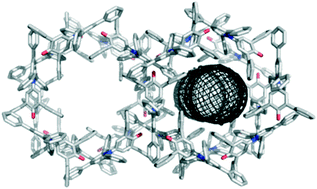
CrystEngComm, 2018,20, 2912-2915
https://doi.org/10.1039/C8CE00480C
Synthesis, structure and characterization of two solvatochromic metal–organic frameworks for chemical-sensing applications
Two isostructural Zr and Hf metal–organic frameworks with doubly interpenetrated fcu-c topology, exhibits obvious solvatochromic behaviour for solvent sensing application.
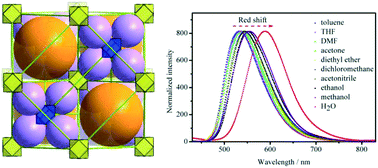
CrystEngComm, 2018,20, 2237-2240
https://doi.org/10.1039/C8CE00204E
Reversible mechanochromic and thermochromic luminescence switching via hydrogen-bond-directed assemblies in a zinc coordination complex
A zinc coordination complex with terpyridyl derivative as ligand exhibits mechanochromic and thermochromic luminescence behaviors with reversible color changes visible to the naked eye from pink to blue-purple upon mechanical grinding and from pink to blue upon heating.
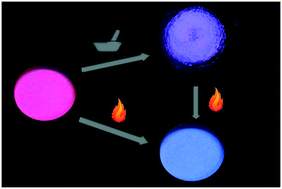
CrystEngComm, 2017,19, 6259-6262
https://doi.org/10.1039/C7CE01511A
Structure-dependent mechanochromism of two Ag(I) imidazolate chains
A Ag(I)-imidazolate coordination polymer showed unique luminescence mechanochromism due to the Ag⋯Ag and C–H⋯π interactions.

CrystEngComm, 2016,18, 218-221
https://doi.org/10.1039/C5CE01852H
Two novel multichromic coordination polymers based on a new flexible viologen ligand exhibiting photocontrolled luminescence properties and sensitive detection for ammonia
Two novel Cd-CPs based on a new viologen ligand exhibiting photochromism, thermochromism, photocontrolled luminescence properties, thermocontrolled luminescence properties and ammonia detection.
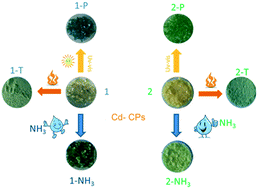
CrystEngComm, 2019,21, 1635-1641
https://doi.org/10.1039/C8CE01948G
A stable anionic metal–organic framework with open coordinated sites: selective separation toward cationic dyes and sensing properties
A multifunctional anionic metal–organic framework was successfully synthesized using a new pyridyl–tricarboxylate ligand. It could be applied as a luminescent sensor for Fe3+ ions and TNP and it showed selective adsorption of cationic dyes.
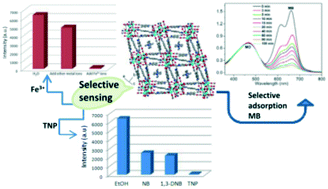
CrystEngComm, 2019,21, 1159-1167
https://doi.org/10.1039/C8CE02060D
Photochromic naphthalene diimide Cd-MOFs based on different second dicarboxylic acid ligands
Three novel 3D calcium-based metal–organic frameworks (FJU-67, FJU-68, and FJU-69) established on naphthalene diimide chromophores have been synthesized, which exhibit unique multiple interpenetrated networks with dia net topologies.
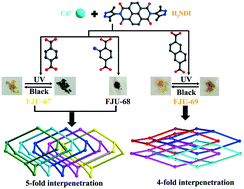
CrystEngComm, 2018,20, 7567-7573
https://doi.org/10.1039/C8CE01667D
Different photochromic properties induced by lone pair–π interactions with varying strengths in two stereocontrolled self-assembly isomeric coordination polymers
The different photochromic properties of two naphthalenediimide-based isometric compounds are derived from two lone pair–π interactions with varying strengths.
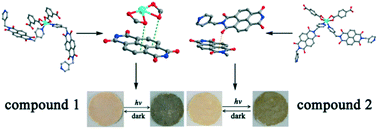
CrystEngComm, 2018,20, 6821-6827
https://doi.org/10.1039/C8CE01367E
Photochromic and photomodulated luminescence properties of two metal–viologen complexes constructed by a tetracarboxylate-anchored bipyridinium-based ligand
Photochromic and photomodulated luminescence properties of two metal–viologen complexes constructed using a tetracarboxylate-anchored bipyridinium-based ligand are reported.
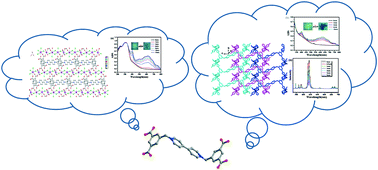
CrystEngComm, 2018,20, 6412-6419
https://doi.org/10.1039/C8CE01335G
The thermo-responsive behavior in molecular crystals of naphthalene diimides and their 3D printed thermochromic composites
Alteration of the number of carbon atoms on the alkoxyphenyl substituent in naphthalene diimides results in tunable thermo-salient behavior.
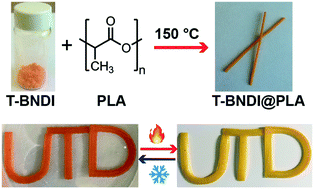
CrystEngComm, 2018,20, 6054-6060
https://doi.org/10.1039/C8CE00798E
The influence of the secondary building linker geometry on the photochromism of naphthalenediimide-based metal–organic frameworks
The photochromism of three MOFs based on NDI chromophores is mainly induced by two kinds of non-covalent intermolecular interactions.

CrystEngComm, 2018,20, 4849-4856
https://doi.org/10.1039/C8CE00892B
The impact of metal ions on photoinduced electron-transfer properties: four photochromic metal–organic frameworks based on a naphthalenediimide chromophore
Four photochromic MOFs show that electron-withdrawing capabilities of metal ions play a significant role in tuning the photosensitivity of photochromic MOFs.
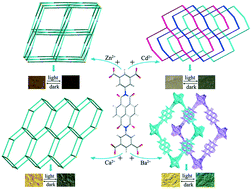
CrystEngComm, 2018,20, 2430-2439
https://doi.org/10.1039/C8CE00213D
Capture of volatile iodine by newly prepared and characterized non-porous [CuI]n-based coordination polymers
Four new non-porous copper(I) iodide coordination polymers have been synthesized and demonstrate volatile iodine capture with simultaneous fluorescence quenching.
![Graphical abstract: Capture of volatile iodine by newly prepared and characterized non-porous [CuI]n-based coordination polymers](/en/Image/Get?imageInfo.ImageType=GA&imageInfo.ImageIdentifier.ManuscriptID=C7CE01193H&imageInfo.ImageIdentifier.Year=2017)
CrystEngComm, 2017,19, 6116-6126
https://doi.org/10.1039/C7CE01193H
Structural response to desolvation in a pyridyl-phenanthrene diarylethene-based metal–organic framework
A phenanthrene-based diarylethene linker with linear pyridyl connectivity, 4,4′-(9,10-bis(2,5-dimethylthiophen-3-yl)phenanthrene-2,7-diyl)dipyridine linker (TPDPy) was prepared and used to synthesize an air-stable metal–organic framework, UBMOF-3, (Zn3(BDC)3(TPDPy)1(DMF)1.5).
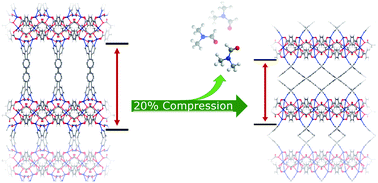
CrystEngComm, 2016,18, 7972-7977
https://doi.org/10.1039/C6CE01783E
About this collection
Chromic materials are of broad interest for their use in optoelectronic devices or in applications such as smart windows, molecular switches, temperature sensors, or for data storage. Framework materials, particularly the structurally robust metal-organic frameworks, have the facility to incorporate responsive moieties within the framework itself or by interaction with other species such as included solvents.
To produce chromic frameworks researchers typically select responsive linkers. For example, photoactive organic linkers can generate a photochromic or photo-induced luminescence response, while conformational isomers may produce a mechanochromic or thermochromic response. While not always clear, the mechanism of response usually depends on non-covalent interactions, such as p-interactions between aromatic facers in linker moieties, or hydrogen bonding between the framework and guest solvents.